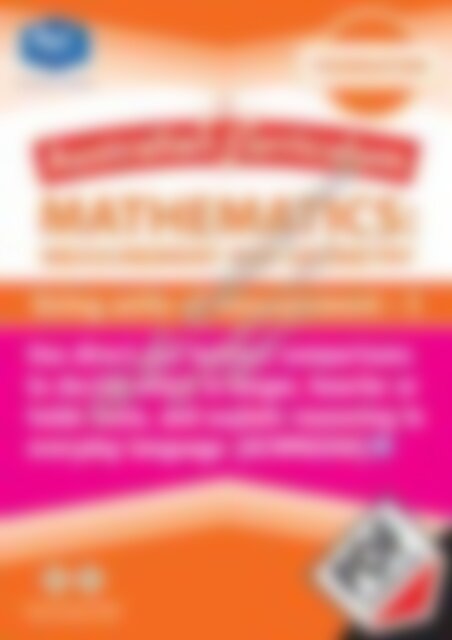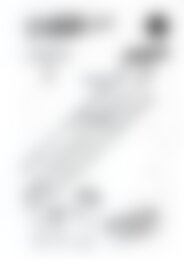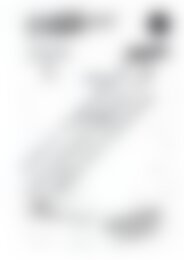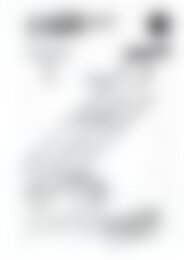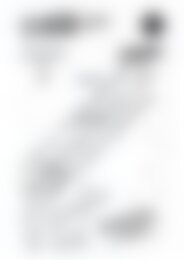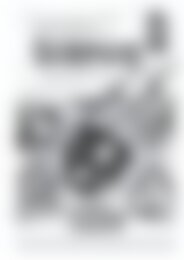RIC-20128 ACM Measurement and Geometry Foundation Using units of measurement 1
Create successful ePaper yourself
Turn your PDF publications into a flip-book with our unique Google optimized e-Paper software.
©R.I.C. Publications<br />
Low Resolution Images<br />
Display Copy
Australian Curriculum Mathematics<br />
resource book: <strong>Measurement</strong> <strong>and</strong> <strong>Geometry</strong><br />
(<strong>Foundation</strong>)<br />
Published by R.I.C. Publications ® 2013<br />
Copyright © Linda Marshall 2013<br />
<strong>RIC</strong>–<strong>20128</strong><br />
Titles in this series:<br />
Australian Curriculum Mathematics resource book:<br />
<strong>Measurement</strong> <strong>and</strong> <strong>Geometry</strong> (<strong>Foundation</strong>)<br />
Australian Curriculum Mathematics resource book:<br />
<strong>Measurement</strong> <strong>and</strong> <strong>Geometry</strong> (Year 1)<br />
Australian Curriculum Mathematics resource book:<br />
<strong>Measurement</strong> <strong>and</strong> <strong>Geometry</strong> (Year 2)<br />
Australian Curriculum Mathematics resource book:<br />
<strong>Measurement</strong> <strong>and</strong> <strong>Geometry</strong> (Year 3)<br />
Australian Curriculum Mathematics resource book:<br />
<strong>Measurement</strong> <strong>and</strong> <strong>Geometry</strong> (Year 4)<br />
Australian Curriculum Mathematics resource book:<br />
<strong>Measurement</strong> <strong>and</strong> <strong>Geometry</strong> (Year 5)<br />
Australian Curriculum Mathematics resource book:<br />
<strong>Measurement</strong> <strong>and</strong> <strong>Geometry</strong> (Year 6)<br />
All material identified by is material subject to<br />
copyright under the Copyright Act 1968 (Cth) <strong>and</strong> is owned<br />
by the Australian Curriculum, Assessment <strong>and</strong> Reporting<br />
Authority 2013.<br />
For all Australian Curriculum material except<br />
elaborations: This is an extract from the Australian<br />
Curriculum.<br />
Elaborations: This may be a modified extract from the<br />
Australian Curriculum <strong>and</strong> may include the work <strong>of</strong> other<br />
authors.<br />
Disclaimer: ACARA neither endorses nor verifies the<br />
accuracy <strong>of</strong> the information provided <strong>and</strong> accepts no<br />
responsibility for incomplete or inaccurate information. In<br />
particular, ACARA does not endorse or verify that:<br />
• The content descriptions are solely for a particular year<br />
<strong>and</strong> subject;<br />
• All the content descriptions for that year <strong>and</strong> subject<br />
have been used; <strong>and</strong><br />
• The author’s material aligns with the Australian<br />
Curriculum content descriptions for the relevant year<br />
<strong>and</strong> subject.<br />
You can find the unaltered <strong>and</strong> most up to date version <strong>of</strong><br />
this material at http://www.australiancurriculum.edu.au/<br />
This material is reproduced with the permission <strong>of</strong> ACARA.<br />
Copyright Notice<br />
A number <strong>of</strong> pages in this book are worksheets.<br />
The publisher licenses the individual teacher who<br />
purchased this book to photocopy these pages to<br />
h<strong>and</strong> out to students in their own classes.<br />
Except as allowed under the Copyright Act 1968, any<br />
other use (including digital <strong>and</strong> online uses <strong>and</strong> the<br />
creation <strong>of</strong> overhead transparencies or posters) or<br />
any use by or for other people (including by or for<br />
other teachers, students or institutions) is prohibited.<br />
If you want a licence to do anything outside the<br />
scope <strong>of</strong> the BLM licence above, please contact the<br />
Publisher.<br />
This information is provided to clarify the limits <strong>of</strong> this<br />
licence <strong>and</strong> its interaction with the Copyright Act.<br />
For your added protection in the case <strong>of</strong> copyright<br />
inspection, please complete the form below. Retain<br />
this form, the complete original document <strong>and</strong> the<br />
invoice or receipt as pro<strong>of</strong> <strong>of</strong> purchase.<br />
Name <strong>of</strong> Purchaser:<br />
Date <strong>of</strong> Purchase:<br />
Supplier:<br />
School Order# (if applicable):<br />
Signature <strong>of</strong> Purchaser:<br />
©R.I.C. Publications<br />
Low Resolution Images<br />
Display Copy<br />
Internet websites<br />
In some cases, websites or specific URLs may be recommended. While these are checked <strong>and</strong> rechecked at the time <strong>of</strong> publication,<br />
the publisher has no control over any subsequent changes which may be made to webpages. It is strongly recommended that the class<br />
teacher checks all URLs before allowing students to access them.<br />
View all pages online<br />
PO Box 332 Greenwood Western Australia 6924<br />
Website: www.ricpublications.com.au<br />
Email: mail@ricgroup.com.au
AUSTRALIAN CUR<strong>RIC</strong>ULUM MATHEMATICS<br />
RESOURCE BOOK:<br />
MEASUREMENT AND GEOMETRY<br />
(FOUNDATION)<br />
Foreword<br />
Australian Curriculum Mathematics resource book: <strong>Measurement</strong> <strong>and</strong> <strong>Geometry</strong> (<strong>Foundation</strong>) is one in a series <strong>of</strong> seven teacher resource books that<br />
support teaching <strong>and</strong> learning activities in Australian Curriculum Mathematics. The books focus on the <strong>measurement</strong> <strong>and</strong> geometry content str<strong>and</strong>s <strong>of</strong><br />
the national maths curriculum. The resource books include theoretical background information, resource sheets, h<strong>and</strong>s-on activities <strong>and</strong> assessment<br />
activities, along with links to other curriculum areas.<br />
Format <strong>of</strong> this book ....................................................................... iv – v<br />
<strong>Using</strong> <strong>units</strong> <strong>of</strong> <strong>measurement</strong> ...........................................................2–29<br />
• UUM – 1<br />
Use direct <strong>and</strong> indirect comparisons to decide which is longer, heavier or<br />
holds more, <strong>and</strong> explain reasoning in everyday language (<strong>ACM</strong>MG006)<br />
– Teacher information ..................................................................................2–3<br />
– H<strong>and</strong>s-on activities ....................................................................................... 4<br />
– Links to other curriculum areas ..................................................................... 5<br />
– Resource sheets .......................................................................................6–13<br />
– Assessment ...........................................................................................14–16<br />
– Checklist ...................................................................................................... 17<br />
• UUM – 2<br />
Compare <strong>and</strong> order the duration <strong>of</strong> events using the everyday language<br />
<strong>of</strong> time (<strong>ACM</strong>MG007)<br />
– Teacher information .................................................................................... 18<br />
– H<strong>and</strong>s-on activities ..................................................................................... 19<br />
– Links to other curriculum areas ................................................................... 20<br />
– Resource sheets .....................................................................................21–23<br />
– Assessment ................................................................................................. 24<br />
– Checklist ...................................................................................................... 25<br />
• UUM – 3<br />
Connect days <strong>of</strong> the week to familiar events <strong>and</strong> actions (<strong>ACM</strong>MG008)<br />
– Teacher information .................................................................................... 26<br />
– H<strong>and</strong>s-on activities ..................................................................................... 27<br />
– Links to other curriculum areas ................................................................... 28<br />
– Checklist ...................................................................................................... 29<br />
Contents<br />
Shape ........................................................................................ 30–43<br />
• Shape – 1<br />
Sort, describe <strong>and</strong> name familiar two-dimensional shapes <strong>and</strong><br />
three-dimensional objects in the environment (<strong>ACM</strong>MG009)<br />
– Teacher information ....................................................................................30<br />
– H<strong>and</strong>s-on activities .....................................................................................31<br />
– Links to other curriculum areas ...................................................................32<br />
– Resource sheets .................................................................................... 33–41<br />
– Assessment .................................................................................................42<br />
– Checklist ......................................................................................................43<br />
Location <strong>and</strong> transformation ....................................................... 44–53<br />
• L&T – 1<br />
Describe position <strong>and</strong> movement (<strong>ACM</strong>MG010)<br />
– Teacher information ....................................................................................44<br />
– H<strong>and</strong>s-on activities .............................................................................. 45–46<br />
– Links to other curriculum areas ...................................................................47<br />
– Resource sheets .................................................................................... 48–50<br />
– Assessment .......................................................................................... 51–52<br />
– Checklist ......................................................................................................53<br />
©R.I.C. Publications<br />
Low Resolution Images<br />
Display Copy<br />
Australian Curriculum Mathematics resource book: <strong>Measurement</strong> <strong>and</strong> <strong>Geometry</strong> (<strong>Foundation</strong>) R.I.C. Publications ® www.ricpublications.com.au iii
FORMAT OF THIS BOOK<br />
This teacher resource book includes supporting materials for teaching <strong>and</strong> learning in all sections <strong>of</strong> the <strong>Measurement</strong> <strong>and</strong> <strong>Geometry</strong> content<br />
str<strong>and</strong> <strong>of</strong> Australian Curriculum Mathematics. It includes activities relating to all sub-str<strong>and</strong>s: <strong>Using</strong> <strong>units</strong> <strong>of</strong> <strong>measurement</strong>, Shape, <strong>and</strong> Location <strong>and</strong><br />
transformation. All content descriptions have been included, as well as teaching points based on the curriculum’s elaborations. Links to the pr<strong>of</strong>iciency<br />
str<strong>and</strong>s have also been included.<br />
Each section supports a specific content description <strong>and</strong> follows a consistent format, containing the following information over several pages:<br />
• teacher information with related terms, student vocabulary, what the content description means, teaching points <strong>and</strong> problems to watch for<br />
• h<strong>and</strong>s-on activities<br />
• links to other curriculum areas<br />
• resource sheets<br />
• assessment sheets.<br />
• a checklist<br />
The length <strong>of</strong> each content description section varies.<br />
Related terms includes vocabulary associated<br />
with the content description. Many <strong>of</strong> these<br />
relate to the glossary in the back <strong>of</strong> the <strong>of</strong>ficial<br />
Australian Curriculum Mathematics document;<br />
additional related terms may also have been<br />
added.<br />
Student vocabulary includes words which<br />
the teacher would use—<strong>and</strong> expect the<br />
students to learn, underst<strong>and</strong> <strong>and</strong> use—during<br />
mathematics lessons.<br />
The pr<strong>of</strong>iciency str<strong>and</strong>(s) (Underst<strong>and</strong>ing,<br />
Fluency, Problem solving or Reasoning) relevant<br />
to each content description are shown in bold.<br />
H<strong>and</strong>s-on activities includes descriptions or<br />
instructions for games or activities relating to the<br />
content descriptions or elaborations. Some <strong>of</strong> the<br />
h<strong>and</strong>s-on activities are supported by resource<br />
sheets. Where applicable, these will be stated for<br />
easy reference.<br />
Teacher information includes background information relating to the content description, as well as<br />
related terms, <strong>and</strong> desirable student vocabulary <strong>and</strong> other useful details which may assist the teacher.<br />
What this means provides<br />
a general explanation <strong>of</strong> the<br />
content description.<br />
Teaching points provides<br />
a list <strong>of</strong> the main teaching<br />
points relating to the content<br />
description.<br />
What to look for suggests any<br />
difficulties <strong>and</strong> misconceptions<br />
the students might encounter or<br />
develop.<br />
©R.I.C. Publications<br />
Low Resolution Images<br />
Display Copy<br />
iv Australian Curriculum Mathematics resource book: <strong>Measurement</strong> <strong>and</strong> <strong>Geometry</strong> (<strong>Foundation</strong>) R.I.C. Publications ® www.ricpublications.com.au
FORMAT OF THIS BOOK<br />
Links to other curriculum areas includes activities in other curriculum areas which<br />
support the content description. These are English, Information <strong>and</strong> Communication<br />
Technology, Health <strong>and</strong> Physical Education, Science, The Arts, Languages, <strong>and</strong> Civics <strong>and</strong><br />
Citizenship. This section may list many links or only a few. It may also provide links to<br />
relevant interactive websites appropriate for the age group.<br />
Cross-curricular links reinforce the knowledge that mathematics can be found within, <strong>and</strong><br />
relate to, many other aspects <strong>of</strong> student learning <strong>and</strong> everyday life.<br />
Resource sheets are provided<br />
to support teaching <strong>and</strong> learning<br />
activities for each content description.<br />
The resource sheets could be cards for<br />
games, charts, additional worksheets<br />
for class use or other materials which<br />
the teacher might find useful to use<br />
or display in the classroom. For each<br />
resource sheet, the content description<br />
to which it relates is given.<br />
Assessment pages are included. These<br />
support activities in the H<strong>and</strong>s-on<br />
activities or resource sheets.<br />
©R.I.C. Publications<br />
Low Resolution Images<br />
Display Copy<br />
Each section has a checklist which<br />
teachers may find useful as a place<br />
to keep a record <strong>of</strong> the results <strong>of</strong><br />
assessment activities, or their<br />
observations <strong>of</strong> h<strong>and</strong>s-on activities.<br />
Australian Curriculum Mathematics resource book: <strong>Measurement</strong> <strong>and</strong> <strong>Geometry</strong> (<strong>Foundation</strong>) R.I.C. Publications ® www.ricpublications.com.au v
Sub-str<strong>and</strong>: <strong>Using</strong> <strong>units</strong> <strong>of</strong> <strong>measurement</strong>—UUM – 1<br />
Use direct <strong>and</strong> indirect comparisons to decide which is longer, heavier or holds more, <strong>and</strong> explain<br />
reasoning in everyday language (<strong>ACM</strong>MG006)<br />
RELATED TERMS<br />
TEACHER INFORMATION<br />
Length<br />
• the measure <strong>of</strong> a path or object in one<br />
dimension from end to end.<br />
Mass<br />
• the amount <strong>of</strong> matter, commonly measured<br />
in grams, kilograms, <strong>and</strong> for heavier objects,<br />
tonnes. These <strong>units</strong> are not expected to be<br />
used at this year level.<br />
Note: The term ‘weight’ is commonly used<br />
when, mathematically, the correct term is<br />
‘mass’. Weight is a measure <strong>of</strong> the force <strong>of</strong><br />
gravity acting on an object <strong>and</strong> is used to<br />
measure mass. In the classroom setting, the<br />
distinction is slight, <strong>and</strong> the terms can be<br />
used interchangeably.<br />
Capacity<br />
• the amount a container can hold, usually<br />
related to liquids or pouring.<br />
Note: This is different to volume, which is<br />
how much space the object itself takes up.<br />
Direct comparison<br />
• <strong>Using</strong> only two items; in length, holding<br />
one against the other to see which is longer<br />
or shorter; in mass, hefting the objects<br />
to decide which is heavier or lighter; in<br />
capacity, pouring liquid from one container<br />
to another to decide which holds more or<br />
less.<br />
Indirect comparison<br />
• Still only making decisions about two items,<br />
but using a third component. For example,<br />
in length, using counters to determine<br />
the lengths <strong>of</strong> two pencils, <strong>and</strong> using the<br />
number <strong>of</strong> counters to decide which pencil<br />
is longer or shorter; in mass, using a pan<br />
balance <strong>and</strong> balancing one object against<br />
a group <strong>of</strong> counters, then balancing the<br />
second object against counters, <strong>and</strong> using<br />
the number <strong>of</strong> counters to determine which<br />
is heavier or lighter; in capacity, using<br />
one measure (e.g. a scoop) <strong>and</strong> counting<br />
how many it takes to fill each <strong>of</strong> the two<br />
containers, then comparing the number <strong>of</strong><br />
scoops to decide which holds more or less.<br />
What this means<br />
• Students compare the length <strong>of</strong> two objects directly by placing<br />
one against another <strong>and</strong> seeing which is longer.<br />
• They compare them indirectly when they measure the length <strong>of</strong><br />
each object with other objects such as counters or pebbles <strong>and</strong><br />
count to see which one has more.<br />
• Students may heft (hold a different object in each h<strong>and</strong>) to decide<br />
which is the heavier <strong>of</strong> two objects.<br />
• Students pour from one container to another to determine which<br />
container holds more.<br />
Teaching points<br />
• With students <strong>of</strong> this age, the objects to be compared according<br />
to their lengths, masses or capacities need to be quite different so<br />
that the students can decide without too much difficulty which is<br />
longer, heavier or holds more.<br />
• If students are using multiples <strong>of</strong> a unit to compare the lengths <strong>of</strong><br />
two other objects, e.g. counters, they need to line them up without<br />
gaps or overlaps <strong>and</strong> start from the same place.<br />
• Estimation should be encouraged before students undertake<br />
any <strong>measurement</strong>. Estimations can then be revised after some<br />
measuring has taken place.<br />
What to look for<br />
• When comparing lengths directly, the students need to have the<br />
end <strong>of</strong> one object level with the end <strong>of</strong> the other.<br />
• When using another object to compare length, students need to<br />
lay them out in a straight line (not zigzagged), with no gaps or<br />
overlaps.<br />
©R.I.C. Publications<br />
Low Resolution Images<br />
Display Copy<br />
• The objects need to be large enough so that the students can<br />
count the number needed.<br />
✓<br />
✘<br />
2 Australian Curriculum Mathematics resource book: <strong>Measurement</strong> <strong>and</strong> <strong>Geometry</strong> (<strong>Foundation</strong>) R.I.C. Publications ® www.ricpublications.com.au
Sub-str<strong>and</strong>: <strong>Using</strong> <strong>units</strong> <strong>of</strong> <strong>measurement</strong>—UUM – 1<br />
Use direct <strong>and</strong> indirect comparisons to decide which is longer, heavier or holds more, <strong>and</strong> explain<br />
reasoning in everyday language (<strong>ACM</strong>MG006)<br />
RELATED TERMS<br />
TEACHER INFORMATION (CONTINUED)<br />
Hefting<br />
• Holding an object in each h<strong>and</strong> <strong>and</strong><br />
trying to decide which is heavier. It <strong>of</strong>ten<br />
helps students decide if they then swap<br />
h<strong>and</strong>s <strong>and</strong> re-do the comparison.<br />
Note: When we compare two objects, we<br />
use the terms long, longer, heavy, heavier,<br />
holds more, holds less. When there are<br />
more than two objects, this is called<br />
seriation or ordering, <strong>and</strong> we then use the<br />
terms shortest, longest, lightest, heaviest<br />
<strong>and</strong> holds the least, holds the most.<br />
Ordering is not expected at <strong>Foundation</strong><br />
level, only the comparison <strong>of</strong> two objects.<br />
• Hefting is quite a difficult skill. Children may need practice at this. It<br />
helps to suggest that they swap the items in each h<strong>and</strong> <strong>and</strong> see if<br />
they still agree which <strong>of</strong> the two objects is heavier.<br />
• You cannot usually determine which is the heavier <strong>of</strong> two objects<br />
just by looking at them; e.g. a golf ball is heavier than a balloon,<br />
but visually not as large.<br />
• When pouring water or s<strong>and</strong> from one container to another, once<br />
one is full, some students have difficulty then deciding what this<br />
means, or which one holds more. Seeing a full container <strong>and</strong> one<br />
with some left in it, can lead some students to believe that the full<br />
one must hold more, even though it has been filled from the first<br />
container with some left over.<br />
©R.I.C. Publications<br />
Low Resolution Images<br />
Display Copy<br />
Student vocabulary<br />
tall<br />
taller than<br />
long<br />
longer than<br />
the same length as<br />
short<br />
shorter than<br />
holds more than<br />
hold less than<br />
holds the same as<br />
Pr<strong>of</strong>iciency str<strong>and</strong>(s):<br />
Underst<strong>and</strong>ing<br />
Fluency<br />
Problem solving<br />
Reasoning<br />
Australian Curriculum Mathematics resource book: <strong>Measurement</strong> <strong>and</strong> <strong>Geometry</strong> (<strong>Foundation</strong>) R.I.C. Publications ® www.ricpublications.com.au 3
Sub-str<strong>and</strong>: <strong>Using</strong> <strong>units</strong> <strong>of</strong> <strong>measurement</strong>—UUM – 1<br />
Length<br />
HANDS-ON ACTIVITIES<br />
Estimate before measuring in all these activities.<br />
• Have pairs <strong>of</strong> real objects where one <strong>of</strong> the pair is large <strong>and</strong> the other small. This may be two books, two dolls, two<br />
pencils, two blocks etc. Ask the students which is the larger or smaller <strong>of</strong> each pair. Then discuss how they could find<br />
out which is the larger.<br />
• Direct measure: Use the pictures on page 6. Discuss which <strong>of</strong> the two crocodiles is long <strong>and</strong> which is longer; or which <strong>of</strong><br />
the snakes is small <strong>and</strong> which is smaller. Children may make their decision based on the visual image. However, when<br />
the objects are not lined up from the same starting point, they may need to cut them out <strong>and</strong> overlay them, making<br />
sure that they are starting at the same point.<br />
• Have the student select six different objects to measure. For each one, students choose a unit such as counters or paper<br />
clips to measure it directly. They estimate first <strong>and</strong> then check by measuring. Use the table on page 8 to record findings.<br />
• Indirect measure: Use the pictures <strong>of</strong> butterflies <strong>and</strong> ladybugs on page 7, but ask the students to line up counters,<br />
blocks, beans, or some other non-st<strong>and</strong>ard unit along each <strong>of</strong> the pairs. Based on the number <strong>of</strong> <strong>units</strong> used, they then<br />
decide which <strong>of</strong> the pair is longer or shorter. They will need to use <strong>units</strong> that, when lined up on the pictures, give a<br />
number that is within the their counting range. Discuss the lining up <strong>of</strong> their <strong>units</strong>, with no gaps or overlaps, <strong>and</strong> not<br />
zigzagged.<br />
• Ask students to use playdough <strong>and</strong> roll out a ‘snake’ that is as long as their foot. Can they now make it longer than their<br />
foot?<br />
Mass<br />
• Have pairs <strong>of</strong> real objects where one <strong>of</strong> the pair is heavy <strong>and</strong><br />
the other light. This may be two books, two dolls, two pencils,<br />
two blocks etc. Ask the students which is the heavier or lighter<br />
<strong>of</strong> each pair. Note: The student needs to h<strong>and</strong>le the objects to<br />
determine which is the heavier; they cannot usually determine<br />
which is heavier just by looking at them.<br />
• The use <strong>of</strong> pan balances will help students to determine the<br />
heavier <strong>of</strong> a pair <strong>of</strong> objects. Discussion will need to take place<br />
to help students decide whether the pan that goes down<br />
contains the heavier or lighter object. Students can record<br />
their results by drawing pictures <strong>of</strong> the objects in the pan<br />
balance on paper or by using page 9.<br />
• The use <strong>of</strong> hefting is another way to compare the masses <strong>of</strong><br />
two objects. Teachers can help the children to decide which<br />
is lighter or heavier by having them place the two articles in<br />
their cupped h<strong>and</strong>s <strong>and</strong> then simulating pan balances. A good<br />
suggestion is to change the h<strong>and</strong> <strong>and</strong> see if they still agree on<br />
which object is heavier. Again, recording their results can be by<br />
drawing them or using page 10.<br />
• Try to include examples where the heavier object is smaller than the larger one, e.g. a golf ball <strong>and</strong> a balloon; a large<br />
hollow plastic cube <strong>and</strong> a small wooden one; or a large, light paper book <strong>and</strong> a small, heavier cardboard one.<br />
• Have pairs <strong>of</strong> objects for students to compare using balance pans. The students record their results by drawing or by<br />
using the table on page 11.<br />
Capacity<br />
©R.I.C. Publications<br />
Low Resolution Images<br />
Display Copy<br />
• Have free play with the water trolley or s<strong>and</strong> tray <strong>and</strong> different sized containers so that students can pour from one to<br />
another. Also have funnels available to make pouring from one container to another easier <strong>and</strong> more enjoyable. Ask<br />
questions such as: Which <strong>of</strong> these two containers holds more? Which one holds less? Some students may be confused by<br />
the visual image <strong>of</strong> the smaller container being full once some <strong>of</strong> the contents <strong>of</strong> the larger one have been poured in,<br />
with the larger one still having some left in it.<br />
• Discuss the ideas <strong>of</strong> ‘full’, ‘half full’ <strong>and</strong> ‘empty’.<br />
• Students use rice or small pasta <strong>and</strong> pour into one container to fill it. Students then pour the contents into a second<br />
container <strong>and</strong> see whether it fills it completely, if there is any left over in the first container, or if there is still room in the<br />
second container even after all the contents have been transferred. Discuss what it means when the second container<br />
overflows, or when it is not full after pouring from the first to the second container. What does it mean? Which container<br />
holds more?<br />
4 Australian Curriculum Mathematics resource book: <strong>Measurement</strong> <strong>and</strong> <strong>Geometry</strong> (<strong>Foundation</strong>) R.I.C. Publications ® www.ricpublications.com.au
Sub-str<strong>and</strong>: <strong>Using</strong> <strong>units</strong> <strong>of</strong> <strong>measurement</strong>—UUM – 1<br />
HANDS-ON ACTIVITIES (CONTINUED)<br />
Capacity (continued)<br />
• Alternatively, ask the student to fill the smaller container <strong>and</strong> then pour it into the larger one. This is visually less<br />
confusing, as the smaller container is now empty <strong>and</strong> the larger one has some water or s<strong>and</strong> in it, but some room left.<br />
• If both containers are quite large, e.g. a bucket <strong>and</strong> an ice-cream carton, students may use a smaller container <strong>and</strong><br />
count how many <strong>of</strong> them are needed to fill each <strong>of</strong> the pair. Make sure the results are within the students’ counting<br />
range.<br />
• The students record the results <strong>of</strong> their comparisons by drawing the two containers <strong>and</strong> writing the words ‘holds more’<br />
under the container with the largest capacity <strong>and</strong> ‘holds less’ under the one with the smaller capacity; or by using<br />
page 12. This page contains pictures <strong>of</strong> ‘containers’ that cannot be measured by students, such as a bath <strong>and</strong> a<br />
swimming pool. In these instances, students decide on which <strong>of</strong> the two ‘containers’ would hold more from their own<br />
knowledge. This could be used as a stimulus for discussion about holding more or less.<br />
English<br />
LINKS TO OTHER CUR<strong>RIC</strong>ULUM AREAS<br />
• Students draw pictures <strong>of</strong> their comparisons <strong>and</strong> write the appropriate words about their findings. They use words such<br />
as long, longer; heavy, heavier; holds more, holds less.<br />
• Read Watch out! Big Bro’s coming by J Alborough. Discuss how Big Bro is so much bigger than his brother. Ask questions<br />
such as: Who is bigger? Who is smaller? What about the other animals?<br />
• Read Shrinking mouse by Pat Hutchins.<br />
• Read Big <strong>and</strong> small by J Pipe.<br />
Health <strong>and</strong> Physical Education<br />
• Students can take small steps <strong>and</strong> long steps; or small jumps <strong>and</strong> long jumps. Make the smallest step or jump you can;<br />
now make the longest step or jump you can.<br />
• In pairs, who can make the longer jump? Is your jump longer or shorter than your partner’s jump? How do you know?<br />
Discuss the need to start from the same point to be able to make a suitable comparison.<br />
The Arts<br />
• Students draw two snakes; one long <strong>and</strong> one longer.<br />
• Use playdough or plasticine to create long <strong>and</strong> longer snakes, or other long <strong>and</strong> longer articles.<br />
• Students each roll a snake shape from playdough or plasticine <strong>and</strong> try to find objects in the room that are longer than,<br />
shorter than, or about the same length as their snake.<br />
Science<br />
• Students compare items collected from the outside environment, e.g. two leaves or flowers for length, two gumnuts or<br />
rocks for mass.<br />
Languages<br />
©R.I.C. Publications<br />
Low Resolution Images<br />
Display Copy<br />
• Students learn the words for long, longer, short, shorter, heavy, heavier, holds more <strong>and</strong> holds less in another language.<br />
Australian Curriculum Mathematics resource book: <strong>Measurement</strong> <strong>and</strong> <strong>Geometry</strong> (<strong>Foundation</strong>) R.I.C. Publications ® www.ricpublications.com.au 5
Sub-str<strong>and</strong>: <strong>Using</strong> <strong>units</strong> <strong>of</strong> <strong>measurement</strong>—UUM – 1<br />
RESOURCE SHEET<br />
Length<br />
Write long or longer under each crocodile.<br />
Write small or smaller under each snake.<br />
©R.I.C. Publications<br />
Low Resolution Images<br />
Display Copy<br />
CONTENT DESCRIPTION : Use direct <strong>and</strong> indirect comparisons to decide which is longer, heavier or holds more, <strong>and</strong> explain reasoning in everyday language<br />
6 Australian Curriculum Mathematics resource book: <strong>Measurement</strong> <strong>and</strong> <strong>Geometry</strong> (<strong>Foundation</strong>) R.I.C. Publications ® www.ricpublications.com.au
Sub-str<strong>and</strong>: <strong>Using</strong> <strong>units</strong> <strong>of</strong> <strong>measurement</strong>— UUM – 1<br />
RESOURCE SHEET<br />
Length<br />
CONTENT DESCRIPTION : Use direct <strong>and</strong> indirect comparisons to decide which is longer, heavier or holds more, <strong>and</strong> explain reasoning in everyday language<br />
Write long or longer under each butterfly.<br />
©R.I.C. Publications<br />
Low Resolution Images<br />
Display Copy<br />
Write short or shorter under each ladybug.<br />
Australian Curriculum Mathematics resource book: <strong>Measurement</strong> <strong>and</strong> <strong>Geometry</strong> (<strong>Foundation</strong>) R.I.C. Publications ® www.ricpublications.com.au 7
Sub-str<strong>and</strong>: <strong>Using</strong> <strong>units</strong> <strong>of</strong> <strong>measurement</strong>—UUM – 1<br />
RESOURCE SHEET<br />
Length<br />
• Choose 6 objects • Draw them • Estimate how long they are<br />
• Check by measuring with chosen <strong>units</strong> such as counters,<br />
blocks etc.<br />
Object Estimate Actual measure<br />
©R.I.C. Publications<br />
Low Resolution Images<br />
Display Copy<br />
CONTENT DESCRIPTION : Use direct <strong>and</strong> indirect comparisons to decide which is longer, heavier or holds more, <strong>and</strong> explain reasoning in everyday language<br />
8 Australian Curriculum Mathematics resource book: <strong>Measurement</strong> <strong>and</strong> <strong>Geometry</strong> (<strong>Foundation</strong>) R.I.C. Publications ® www.ricpublications.com.au
Sub-str<strong>and</strong>: <strong>Using</strong> <strong>units</strong> <strong>of</strong> <strong>measurement</strong>—UUM – 1<br />
RESOURCE SHEET<br />
Which one is heavier?<br />
CONTENT DESCRIPTION : Use direct <strong>and</strong> indirect comparisons to decide which is longer, heavier or holds more, <strong>and</strong> explain reasoning in everyday language<br />
Draw one object on each side.<br />
Write heavy or heavier under each side.<br />
©R.I.C. Publications<br />
Low Resolution Images<br />
Display Copy<br />
Draw one object on each side.<br />
Write heavy or heavier under each side.<br />
Australian Curriculum Mathematics resource book: <strong>Measurement</strong> <strong>and</strong> <strong>Geometry</strong> (<strong>Foundation</strong>) R.I.C. Publications ® www.ricpublications.com.au 9
Sub-str<strong>and</strong>: <strong>Using</strong> <strong>units</strong> <strong>of</strong> <strong>measurement</strong>—UUM – 1<br />
RESOURCE SHEET<br />
Which one is heavier?<br />
Draw two objects. Circle the heavier one.<br />
©R.I.C. Publications<br />
Low Resolution Images<br />
Display Copy<br />
Draw yourself holding two objects. Circle the heavier one.<br />
CONTENT DESCRIPTION : Use direct <strong>and</strong> indirect comparisons to decide which is longer, heavier or holds more, <strong>and</strong> explain reasoning in everyday language<br />
10 Australian Curriculum Mathematics resource book: <strong>Measurement</strong> <strong>and</strong> <strong>Geometry</strong> (<strong>Foundation</strong>) R.I.C. Publications ® www.ricpublications.com.au
Sub-str<strong>and</strong>: <strong>Using</strong> <strong>units</strong> <strong>of</strong> <strong>measurement</strong>—UUM – 1<br />
RESOURCE SHEET<br />
Which one is heavier?<br />
Put each pair <strong>of</strong> objects onto balance pans. Circle the one<br />
that is heavier.<br />
CONTENT DESCRIPTION : Use direct <strong>and</strong> indirect comparisons to decide which is longer, heavier or holds more, <strong>and</strong> explain reasoning in everyday language<br />
Crayons<br />
0 1 2 3 4 5 6<br />
©R.I.C. Publications<br />
Low Resolution Images<br />
Display Copy<br />
Australian Curriculum Mathematics resource book: <strong>Measurement</strong> <strong>and</strong> <strong>Geometry</strong> (<strong>Foundation</strong>) R.I.C. Publications ® www.ricpublications.com.au 11
Sub-str<strong>and</strong>: <strong>Using</strong> <strong>units</strong> <strong>of</strong> <strong>measurement</strong>—UUM – 1<br />
Write holds more or holds less.<br />
RESOURCE SHEET<br />
Holds more or holds less<br />
The<br />
The<br />
The<br />
The<br />
The<br />
than the<br />
than the<br />
than the<br />
©R.I.C. Publications<br />
Low Resolution Images<br />
Display Copy<br />
than the<br />
than the<br />
CONTENT DESCRIPTION : Use direct <strong>and</strong> indirect comparisons to decide which is longer, heavier or holds more, <strong>and</strong> explain reasoning in everyday language<br />
12 Australian Curriculum Mathematics resource book: <strong>Measurement</strong> <strong>and</strong> <strong>Geometry</strong> (<strong>Foundation</strong>) R.I.C. Publications ® www.ricpublications.com.au
Sub-str<strong>and</strong>: <strong>Using</strong> <strong>units</strong> <strong>of</strong> <strong>measurement</strong>—UUM – 1<br />
RESOURCE SHEET<br />
Choose the right words<br />
Draw arrows to match words to the pictures.<br />
holds more<br />
CONTENT DESCRIPTION : Use direct <strong>and</strong> indirect comparisons to decide which is longer, heavier or holds more, <strong>and</strong> explain reasoning in everyday language<br />
holds less<br />
weighs more<br />
weighs less<br />
taller<br />
shorter<br />
weighs more<br />
weighs less<br />
longer<br />
shorter<br />
holds more<br />
holds less<br />
©R.I.C. Publications<br />
Low Resolution Images<br />
Display Copy<br />
Australian Curriculum Mathematics resource book: <strong>Measurement</strong> <strong>and</strong> <strong>Geometry</strong> (<strong>Foundation</strong>) R.I.C. Publications ® www.ricpublications.com.au 13
Assessment 1 Sub-str<strong>and</strong>: <strong>Using</strong> <strong>units</strong> <strong>of</strong> <strong>measurement</strong>—UUM – 1<br />
NAME:<br />
DATE:<br />
Length<br />
Use blocks to find out which ant is shorter.<br />
Write short or shorter under each ant.<br />
blocks<br />
Use blocks to find out which road is longer.<br />
Write long or longer under each road.<br />
©R.I.C. Publications<br />
Low Resolution Images<br />
Display Copy<br />
blocks<br />
blocks<br />
blocks<br />
CONTENT DESCRIPTION : Use direct <strong>and</strong> indirect comparisons to decide which is longer, heavier or holds more, <strong>and</strong> explain reasoning in everyday language<br />
14 Australian Curriculum Mathematics resource book: <strong>Measurement</strong> <strong>and</strong> <strong>Geometry</strong> (<strong>Foundation</strong>) R.I.C. Publications ® www.ricpublications.com.au
Sub-str<strong>and</strong>: <strong>Using</strong> <strong>units</strong> <strong>of</strong> <strong>measurement</strong>—UUM – 1 Assessment 2<br />
NAME:<br />
DATE:<br />
Heavy/heavier?<br />
Tick the one that is heavier. Use a pan balance to help.<br />
CONTENT DESCRIPTION : Use direct <strong>and</strong> indirect comparisons to decide which is longer, heavier or holds more, <strong>and</strong> explain reasoning in everyday language<br />
0 1 2 3 4 5 6<br />
©R.I.C. Publications<br />
Low Resolution Images<br />
Display Copy<br />
Australian Curriculum Mathematics resource book: <strong>Measurement</strong> <strong>and</strong> <strong>Geometry</strong> (<strong>Foundation</strong>) R.I.C. Publications ® www.ricpublications.com.au 15
Assessment 3 Sub-str<strong>and</strong>: <strong>Using</strong> <strong>units</strong> <strong>of</strong> <strong>measurement</strong>—UUM – 1<br />
NAME:<br />
DATE:<br />
Hold more/Holds less<br />
Pour water or s<strong>and</strong> into two containers.<br />
Draw pictures to show which holds more <strong>and</strong> which<br />
holds less.<br />
holds more<br />
holds less<br />
Choose two different containers.<br />
Draw pictures to show which holds more <strong>and</strong> which<br />
holds less.<br />
holds more<br />
holds less<br />
©R.I.C. Publications<br />
Low Resolution Images<br />
Display Copy<br />
CONTENT DESCRIPTION : Use direct <strong>and</strong> indirect comparisons to decide which is longer, heavier or holds more, <strong>and</strong> explain reasoning in everyday language<br />
16 Australian Curriculum Mathematics resource book: <strong>Measurement</strong> <strong>and</strong> <strong>Geometry</strong> (<strong>Foundation</strong>) R.I.C. Publications ® www.ricpublications.com.au
Sub-str<strong>and</strong>: <strong>Using</strong> <strong>units</strong> <strong>of</strong> <strong>measurement</strong>—UUM – 1<br />
Checklist<br />
Use direct <strong>and</strong> indirect comparisons to decide which is longer, heavier or holds more, <strong>and</strong> explain<br />
reasoning in everyday language (<strong>ACM</strong>MG006)<br />
STUDENT NAME<br />
Compares the<br />
lengths <strong>of</strong> two<br />
objects using the<br />
language <strong>of</strong> long/<br />
longer; short/<br />
shorter<br />
Compares the<br />
masses <strong>of</strong> two<br />
objects using the<br />
language <strong>of</strong> heavy/<br />
heavier<br />
©R.I.C. Publications<br />
Low Resolution Images<br />
Display Copy<br />
Compares the<br />
capacities <strong>of</strong> two<br />
objects using the<br />
language <strong>of</strong> holds<br />
more/holds less<br />
Australian Curriculum Mathematics resource book: <strong>Measurement</strong> <strong>and</strong> <strong>Geometry</strong> (<strong>Foundation</strong>) R.I.C. Publications ® www.ricpublications.com.au 17


